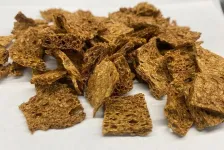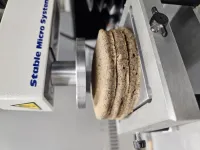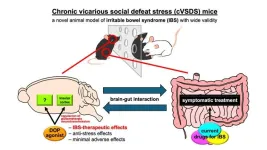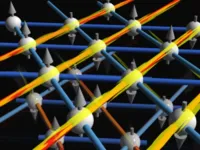(Press-News.org) Reusable sponge platform has successfully removed oil, phosphate and metal from contaminated water
New development allows capture of valuable minerals and reuse of the sponge
Water pollution concentrations move from 0.8 parts per million to undetectable levels
EVANSTON, Ill. --- As more waterways contend with algae blooms and pollution caused by minerals from agricultural runoff and industrial manufacturing processes, new methods to remove pollutants like phosphate, copper and zinc are emerging across fields.
While solutions exist, they tend to be costly and can be used just once. But a specialized sponge created by researchers at Northwestern University that works to slurp up pollutants, and then release them as desired, may present a reusable, low-cost solution.
The sponge, coated with nanoparticles that have an affinity for pollutants, can collect metals like zinc and copper, as well as phosphate, and in previous iterations has successfully pulled lead from water, and microplastics and oil from lakes and oceans. It then releases these valuable resources when it is exposed to different pH’s.
In a paper to be published Feb. 5 in the American Chemical Society journal Environmental Science & Technology Water, researchers define a method to tailor their platform to specific Chicago pollutants and then selectively release them, giving resources that typically must be mined a potential for a second life.
“The technology can be used as a universal sorbent or ‘catch-all,’ or it can be tailored to certain groups of contaminants like metals, plastics or nutrients,” said principal investigator Vinayak Dravid.
Dravid is the Abraham Harris Professor of Materials Science and Engineering at Northwestern’s McCormick School of Engineering and a faculty affiliate of the Paula M. Trienens Institute for Sustainability and Energy. He is also the founding director of the Northwestern University Atomic and Nanoscale Characterization (NUANCE) Center as well as the Soft and Hybrid Nanotechnology Experimental (SHyNE) Resource, and also serves as the associate director for global programs at the International Institute of Nanotechnology.
What’s with the sponge?
In its first iteration, the sponge platform was made of polyurethane and coated with a substance that attracted oil and repelled water. The newest version is a highly hydrophilic (water-loving) cellulose sponge coated with particles tailored to other pollutants. The sponge platform works so effectively because of its pores, providing lots of surface area where pollutants can attach.
Dravid has at times referred to the technology as a “Swiss Army knife” thanks to its versatility and ability to be used again and again. He founded NU startup Coral Innovations (formerly MFNS-Tech) to begin the process of commercializing the sponge-based technology for environmental remediation.
A one-two P(h)unch
Stormwater treatment equipment manufacturer StormTrap, LLC learned about the platform and approached the team, asking about three specific pollutants heavily impacting Chicago. Hoping to add absorbent materials to their portfolio, StormTrap representatives asked if Dravid could get the concentration of pollutants down to untraceable amounts.
The Environmental Protection Agency sets levels for minerals based on human health that are at times higher than the amount considered safe from an environmental perspective, typically setting drinking water limits in the parts per million range when preventing algae blooms and other environmental impacts would require much smaller concentrations.
Developing the platform to capture copper, zinc and phosphate was relatively easy, but then, Kelly Matuszewski, a Ph.D. student in the Dravid group and the paper’s first author, was tasked with determining a method to get the resources back. As stores of phosphate and metals in mines are depleted, this second step is becoming critical.
“We can’t just keep flushing these minerals down the toilet,” Matuszewski said. “We need to understand how they interact and find ways to actually utilize them.”
Matuszewski found that by lowering the pH, metals flush out of the sponge. Once copper and zinc are removed, the pH is then raised, at which point phosphate comes off the sponge. She found that even after five cycles of collecting and removing minerals, the sponge worked just as well, and she was able to deliver water with untraceable amounts of pollutants.
Matuszewski is a finalist in the FoundHer Spotlight, a competition for early career women scientists facilitated by Northwestern’s Querrey inQbation Lab. She will pitch on March 5 to the Northwestern Women’s Board, competing against seven other researchers.
Taking it to the storm drains
The partnership with StormTrap, LLC has allowed the team to assess the technology’s effectiveness and move quickly from the lab to the industry. Using the platform in real-life scenarios will be an important next step, as Matuszewski was working in a controlled environment in which each pollutant had the same relative concentration. The next phase will help them determine the amount of minerals a sponge can hold and allow them to partner with other Northwestern researchers working on creating cleaner waterways.
The paper was funded by Trienens and StormTrap and is based on work related to The Great Lakes Water Innovation Engine supported by the National Science Foundation (grant number ITE-2315268).
Vinayak Dravid and Northwestern have financial interests (equities, royalties) in Coral Innovations.
END
Stormwater pollution sucked up by specialized sponge
Scientists reimagine lifecycle for non-renewables like metals, phosphate
2025-02-05
ELSE PRESS RELEASES FROM THIS DATE:
Value-added pancakes: WSU using science to improve nutrition of breakfast staple
2025-02-05
PULLMAN, Wash. — Typical breakfast pancakes are soft, fluffy and delicious but, sadly, not terribly healthy.
Food scientists at Washington State University are working to change that by boosting the popular morning favorite’s nutritional value while enhancing its taste and texture.
“Generally, pancakes are made with refined flours, contributing to empty calories,” said Girish Ganjyal, a professor and food processing specialist in WSU’s School of Food Science. “We wanted to see if it’s ...
Beyond the gut: A new frontier in IBS treatment by targeting the brain
2025-02-05
Irritable bowel syndrome (IBS) is a common digestive disorder that affects the intestine, causing symptoms such as abdominal pain, bloating, gas, and changes in bowel habits, including diarrhea, constipation, or both. Although this condition affects about a tenth of the global population, the underlying causes and mechanisms of IBS remain unclear. Consequently, treatments for IBS primarily focus on managing symptoms rather than addressing the root cause of the disorder.
At Tokyo University of Science ...
New spin on quantum liquids: Quasi-1D dynamics in molecular spin systems
2025-02-05
Quantum spin liquids (QSLs) are fascinating and mysterious states of matter that have intrigued scientists for decades. First proposed by Nobel laureate Philip Anderson in the 1970s, these materials break the conventional rules of magnetism by never settling into a stable magnetic state, even at temperatures close to absolute zero. Instead, the spins of the atoms within them remain constantly fluctuating and entangled, creating a kind of magnetic “liquid.” This unusual behavior is driven by a phenomenon called magnetic frustration, where competing forces prevent the system from reaching a single, ordered configuration. QSLs are notoriously ...
Spinal cord stimulation restores neural function, targets key feature of progressive neurodegenerative disease
2025-02-05
PITTSBURGH, Feb. 5, 2025 – A new drug-free, minimally invasive intervention targets the root cause of progressive loss of neural function in spinal muscle atrophy (SMA), an inherited neuromuscular disease. An intervention, which involves electrical stimulation of the sensory spinal nerves, can gradually reawaken functionally silent motor neurons in the spinal cord and improve leg muscle strength and walking in adults with SMA. The findings were reported by University of Pittsburgh School of Medicine researchers in Nature Medicine today.
Early results from a pilot clinical trial in three human volunteers with SMA show that one month of regular ...
Shut the nano gate! Electrical control of nanopore diameter
2025-02-05
Osaka, Japan—A gate that can be open or shut to allow or block the passing of species on one or both sides applies not only on the macroscale, for example a farm gate used to control stock movement, but also at the nanoscale, where a gate can control the translocation of single molecules.
A collaboration headed by researchers at Osaka University has developed a nanogate that can be open or shut by applying electricity. The nanogate shows various behaviors depending on the materials in the solutions on both sides of the gate and the applied voltage, making it attractive for different applications including sensing and controlled chemical reactions.
The ...
Cutting emissions in buildings and transport: Key strategies for 2050
2025-02-05
Key findings: a roadmap to transform energy use by 2050
Electrification (e.g., switching to electric vehicles, heat pumps) alone could cut direct emissions by 45-77% in buildings and 22-86% in transport by 2050.
Combining electrification, efficiency improvements, and behavioral changes could reduce emissions even further: 51-85% for buildings and 37-91% for transport by 2050.
A multi-strategy approach would lower overall electricity demand by 8-33% per year, making the transition more cost-effective ...
How parents can protect children from mature and adult content
2025-02-05
Toronto, ON – As children's screen time continues to rise, so does their exposure to age-inappropriate content, including R-rated movies and violent video games. A new study published in BMC Pediatrics underscores the critical role parents play in shaping their children’s media consumption.
As child media consumption increases along with their exposure to mature media content, a new study finds that parent media practices play a key role in shaping preteens’ consumption of mature video games and R-rated movies.
Researchers found that parents’ own screen habits—such as using screens in front of their children and allowing screens during meals ...
By studying neutron ‘starquakes’, scientists hope to transform their understanding of nuclear matter
2025-02-05
The study of ‘starquakes’ (like earthquakes, but in stars) promises to give us important new insights into the properties of neutron stars (the collapsed remnants of massive stars), according to new research led by the University of Bath in the UK.
Such explorations have the potential to challenge our current approaches to studying nuclear matter, with important impacts for the future of both nuclear physics and astronomy. Longer term, there may also be implications in the fields of health, security and energy.
The value of studying asteroseismology – as these vibrations and flares are known – has emerged from research carried ...
Mouth bacteria may hold insight into your future brain function
2025-02-05
The bacteria in your mouth and on your tongue may be linked to changes in brain function as you age, new research suggested.
The study, led by the University of Exeter, found that certain bacteria were associated with better memory and attention, while others were linked to an increased risk of Alzheimer’s disease.
The researchers identified two possible ways these bacteria may impact brain health. This includes harmful bacteria directly entering the bloodstream, potentially causing damage to the brain. Alternatively, an imbalance between beneficial and harmful bacteria can reduce the conversion of ...
Is cellular concrete a viable low-carbon alternative to traditional concrete for earthquake-resistant structures?
2025-02-05
Investigators have found that a product called cellular concrete may be an environmentally friendly alternative to conventional concrete for constructing earthquake-resistant buildings.
In research published in Structural Concrete, the team analyzed the environmental impact of constructing a seven-story archetype residential building in Quito-Ecuador with cellular concrete, which is produced by incorporating a foaming agent that generates air pockets within the concrete matrix to decrease the material’s density while maintaining sufficient structural ...
LAST 30 PRESS RELEASES:
Sports injuries sustained during your period might be more severe
World's first successful 2 Tbit/s free-space optical communication using small optical terminals mountable on satellites and HAPS
Can intimate relationships affect your heart? New study says ‘yes’
Scalable and healable gradient textiles for multi‑scenario radiative cooling via bicomponent blow spinning
Research shows informed traders never let a good climate crisis go to waste
Intelligent XGBoost framework enhances asphalt pavement skid resistance assessment
Dual-function biomaterials for postoperative osteosarcoma: Tumor suppression and bone regeneration
New framework reveals where transport emissions concentrate in Singapore
NTP-enhanced lattice oxygen activation in Ce-Co catalysts for low-temperature soot combustion
Synergistic interface engineering in Cu-Zn-Ce catalysts for efficient CO2 hydrogenation to methanol
COVID-19 leaves a lasting mark on the human brain
Scientists use ultrasound to soften and treat cancer tumors without damaging healthy tissue
Community swimming program for Black youth boosts skills, sense of belonging, study finds
Specific depressive symptoms in midlife linked to increased dementia risk
An ‘illuminating’ design sheds light on cholesterol
Who is more likely to get long COVID?
Study showcases resilience and rapid growth of “living rocks”
Naval Research Lab diver earns Office of Naval Research 2025 Sailor of the Year
New Mayo-led study establishes practical definition for rapidly progressive dementia
Fossil fuel industry’s “climate false solutions” reinforce its power and aggravate environmental injustice
Researchers reveal bias in a widely used measure of algorithm performance
Alcohol causes cancer. A study from IOCB Prague confirms damage to DNA and shows how cells defend against it
Hidden viruses in wastewater treatment may shape public health risks, study finds
Unlock the power of nature: how biomass can transform climate mitigation
Biochar reshapes hidden soil microbes that capture carbon dioxide in farmland
Reducing saturated fat intake shows mortality benefit, but only in high-risk individuals
Manta rays create mobile ecosystems, study finds
Study: Mixed results in using lipoic acid to treat progressive multiple sclerosis
Norbert Holtkamp appointed director of Fermi National Accelerator Laboratory
New agentic AI platform accelerates advanced optics design
[Press-News.org] Stormwater pollution sucked up by specialized spongeScientists reimagine lifecycle for non-renewables like metals, phosphate





